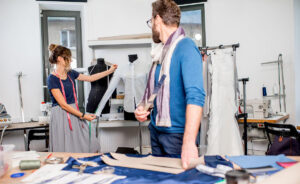What is Embroidery Craft?
Embroidery craft is an essential part of garment design that adds beauty and personality to clothing. In this article, we will explore the definition, history, types, processes, applications, and advantages of embroidery craft in detail.
Definition of Embroidery Craft
Embroidery craft is a decorative technique that combines various threads and needles to create patterns on fabric, either by hand or machine. It enhances the aesthetic appeal of clothing and imparts a personalized style. Embroidery can be applied to various fabrics, such as cotton, silk, and wool, and is suitable for multiple products.
History of Embroidery Craft
Embroidery has a long history, dating back thousands of years. The earliest embroidery can be traced to regions like China and Egypt. In these early cultures, embroidery was used in religious ceremonies and noble attire. As time progressed, embroidery techniques evolved, incorporating different cultures and aesthetics, leading to a variety of styles and methods.
Types of Embroidery Craft
Embroidery can be categorized into several types, including:
1. Hand Embroidery
Hand embroidery is done by embroiderers using needles and threads, featuring unique details and individuality. This method is often used for high-end custom products to meet clients’ personalized needs.
2. Machine Embroidery
Machine embroidery employs embroidery machines for mass production, offering high efficiency and lower costs, suitable for large-scale orders. This method maintains consistent quality, making it ideal for commercial use.
3. Embroidery Techniques
Different embroidery techniques and effects, such as flat embroidery, raised embroidery, and appliqué embroidery, can be chosen based on needs. Each technique has its unique style and application.
Process of Embroidery Craft
The process of embroidery typically involves the following steps:
1. Design
Designing embroidery patterns based on client requirements. This step is crucial, as a good design is the foundation of successful embroidery.
2. Material Selection
Choosing suitable fabrics and threads. Different materials will affect the final embroidery effect and texture.
3. Template Creation
Creating embroidery templates or programming machines. This stage ensures that the design can be accurately realized.
4. Embroidery
Executing the embroidery according to the design, either by hand or machine. Ensuring the quality and detail of the embroidery is critical during this process.
5. Post-Processing
Trimming, cleaning, and finishing to ensure the quality of the embroidery. This step guarantees the aesthetic and durability of the final product.
Application Scenarios of Embroidery
Embroidery is widely used in clothing, home goods, gifts, and various souvenirs. Whether for formal attire, casual wear, or personalized customizations, embroidery adds a distinctive quality. In many cultures, embroidery is also regarded as an important art form.
Advantages of Embroidery Craft
Embroidery craft offers several advantages:
1. Personalization
Embroidery can be designed with unique patterns based on client needs, making each garment more personal. This customization service is particularly popular in the fashion industry.
2. Durability
Embroidery is more robust than printing, with a longer lifespan. This makes embroidery an ideal decorative choice, especially in products requiring durability.
3. Artistic Value
Embroidery reflects traditional craftsmanship, enhancing the overall value and artistic appeal of the product. This uniqueness makes embroidered products more attractive in the market.
Conclusion
Embroidery craft not only beautifies our lives but also carries cultural and artistic significance. With its long history, diverse types, and unique value, embroidery plays a vital role in garment design. In our products, you will find a variety of exquisite embroidery designs, eager to add a touch of brilliance to your clothing.







